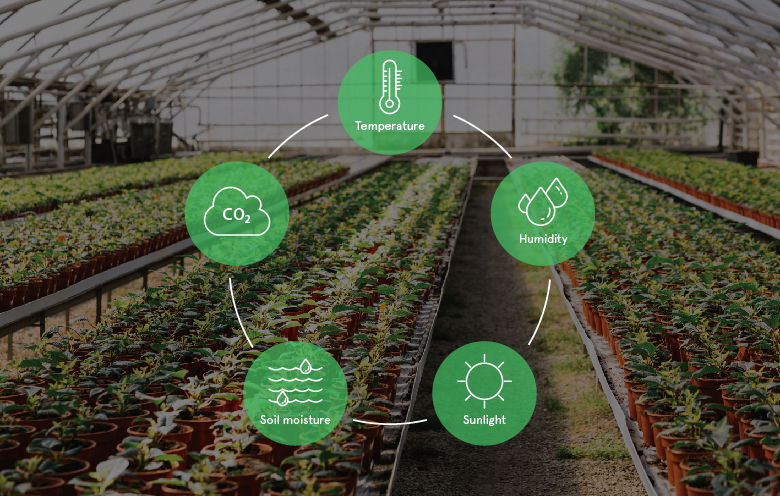We live in a world where almost everything can be operated and controlled automatically, but there are certain areas in which automation is not implemented yet. One such sector is agriculture. Talking about agriculture, it is amongst the primary occupations of humans where manual involvement is unavoidable. Farmers have used traditional methods for growing crops for centuries. But at times it becomes necessary to automate systems for better management of farming processes as well.
With a greenhouse, growers can provide favorable environmental conditions to plants for optimal growth. Greenhouses are more in practice for growing crops these days due to urbanization and lack of land availability. Hence, it has become an important part of the agriculture industry.
As greenhouses are designed to provide controlled climatic conditions, it is necessary to monitor, control and maintain the parameters that are essential for plant growth. Since outside environmental conditions are not steady, it becomes necessary to modify the inside environmental conditions to adjust to the outside changes to achieve higher crop yield at minimum costs.
A greenhouse environment monitoring system helps you to monitor and control various parameters like temperature, humidity, light, irrigation, pH level, soil moisture, carbon dioxide (CO2), etc. in a greenhouse.
The five factors of greenhouse environmental control
There are five main factors which affect a plant’s growth and by controlling them you can provide a microclimate for your crops to grow in a healthier environment.
Temperature
Temperature is one of the most important factors responsible for the growth of plants. The temperature required for appropriate growth differs from plant to plant. Some plants require high temperatures to grow properly, whereas some need low. Hence, it is important to maintain the required temperature for every type of plant.
Apart from the fluctuations in outside temperature, varying greenhouse temperature must be maintained. Plants breathe CO2 and release oxygen (O2) and produce heat in this process that builds up if not maintained. This supports the growth of crops that require a great amount of heat when the outside temperature lowers down. But for the plants that do not require so much heat to grow, it can cause damage and lead to plant diseases. Hence it becomes necessary to regulate this heat in your greenhouse.
A greenhouse monitoring solution sends you triggers in case the temperature fluctuates and enables you to provide the ideal temperature for your crops, fruits, veggies and flowers.
Humidity
Humidity is another important factor essential to maintain plant growth. Plants expel warm and moist oxygen as they grow and process CO2, which makes the greenhouse environment naturally warmer and moist with time.
Some plants require a high moisture level while some need less. The presence of high moisture may lead to the growth of nasty molds and diseases which can be extremely harmful for the crops.
A greenhouse environment control system helps you to monitor heat and ventilation to manage humidity in your greenhouse. This ensures minimum mold growth and maximum plant growth. – Statista
Sunlight
Sunlight is another important factor contributing to a plant’s growth. Plants use it for photosynthesis, which is essential for them to create energy using CO2 and water.
Where some plants prefer strong sunlight, others like it in less intensity. Controlling sunlight has not been possible for growers for long, but a greenhouse set up enables you to control sunlight from entering by use of energy curtains, shade coverings, black-out curtains and UV-filtering poly or plastic coverings. This helps you to keep the light levels optimum and filter out ultraviolet radiation at the same time.
You can install LED lights for uniform light distribution in your greenhouse. A greenhouse monitoring system sends you alerts when the outside light levels go down and you can manage optimum light in the greenhouse by switching on LED lights.
Soil moisture
Soil moisture is a primary factor in farm productivity. It is very important to provide the right amount of water to the plants as low moisture results in poor yield and ruins the plant while too much moisture can cause root diseases and lead to water wastage.
Water is the medium of delivering nutrients to the plants that are not tightly bound to the soil. Therefore, it is important to have good water management to ensure better nutrient management for your crops.
A greenhouse environment controller enables you to maintain, monitor and control proper soil moisture for better plant growth, quality and overall yield.
Carbon dioxide (CO2)
In addition to temperature, humidity, sunlight and soil moisture, plants also need CO2 for photosynthesis (carbon assimilation) which affects their growth and yield. You must monitor CO2 levels and supplement CO2 whenever its level goes down in your greenhouse. Too low CO2 level limits plant growth, but a high level of CO2 is also not beneficial. When you monitor CO2 level and adjust it up to the required level, your plants mature earlier and you can harvest more crops annually. With the help of a smart greenhouse monitoring system, you can constantly monitor the CO2 level and get alerts when it goes below or above the required levels.
The final say
Greenhouses are simple structures, but they have complex settings. This is because a variety of crops requiring different environments are grown inside them. Hence, it becomes complicated to maintain optimal temperature and humidity levels along with all the factors that we have discussed above. So, a greenhouse requires regulation of these parameters depending upon the type of climate that it is built-in.
An IoT-based smart greenhouse monitoring system enables you to monitor and control all these factors easily. The incorporated sensors send you triggers if any parameter goes above or below its preset values and helps you to take proactive measures to save your plants from damage. This results in higher crop yield and profits. To know more about greenhouse monitoring, please talk to our experts.
